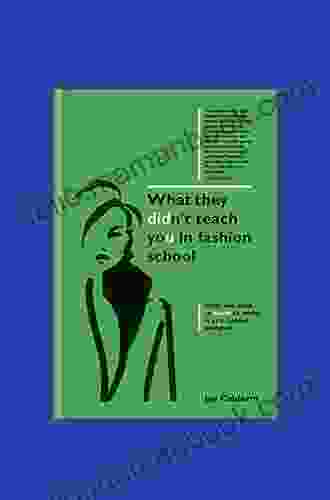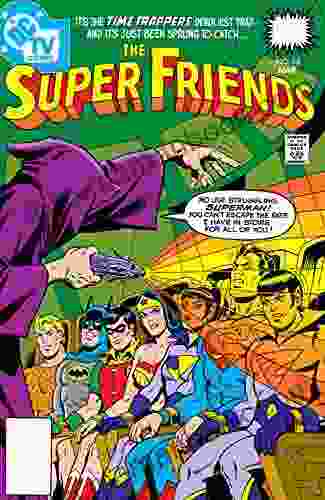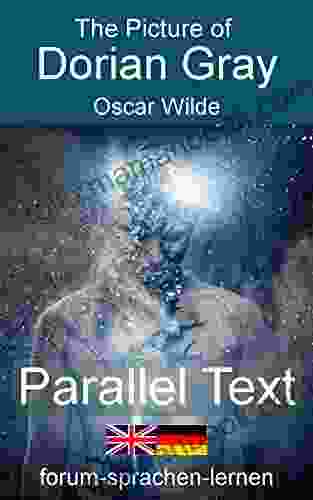The Picture of Dorian Gray Das Bildnis Des Dorian Gray: A Literary Exploration of Beauty, Morality, and the Consequences of Selfishness

The Picture of Dorian Gray, originally published in 1890, is a Gothic novel by Oscar Wilde that explores the themes of beauty, morality, and the consequences of selfishness. The novel tells the story of Dorian Gray, a young man who sells his soul to the devil in exchange for eternal youth and beauty. While Dorian's physical beauty remains unchanged, his soul becomes corrupted as he indulges in a life of hedonism and vice.
The novel has been praised for its beautiful prose and its exploration of complex moral issues. However, it has also been criticized for its pessimistic view of human nature. Despite this, The Picture of Dorian Gray remains one of the most popular and influential works of English literature.
4.8 out of 5
| Language | : | English |
| File size | : | 1952 KB |
| Text-to-Speech | : | Enabled |
| Screen Reader | : | Supported |
| Enhanced typesetting | : | Enabled |
| Print length | : | 180 pages |
| Lending | : | Enabled |
Plot
The Picture of Dorian Gray begins with Dorian Gray, a young man of extraordinary beauty, meeting the artist Basil Hallward. Basil is immediately struck by Dorian's beauty and asks him to sit for a portrait. Dorian agrees, and Basil creates a masterpiece that captures Dorian's youthful beauty and innocence.
After the portrait is finished, Dorian meets Lord Henry Wotton, a cynical and hedonistic aristocrat. Lord Henry introduces Dorian to a life of pleasure and debauchery. Dorian quickly becomes corrupted by Lord Henry's influence and begins to indulge in a series of increasingly depraved acts.
As Dorian's soul becomes corrupted, his portrait changes to reflect his inner ugliness. However, Dorian remains physically unchanged, and his youthful beauty continues to attract others.
Eventually, Dorian's sins catch up with him. He is blackmailed by a former lover and is forced to kill him. Dorian also realizes that his portrait has become so hideous that he can no longer bear to look at it.
In a fit of rage, Dorian destroys the portrait. However, by ng so, he also destroys himself. Dorian's body ages rapidly, and he dies a withered old man.
Themes
The Picture of Dorian Gray explores a number of complex moral issues, including the nature of beauty, the importance of morality, and the consequences of selfishness.
Beauty is a central theme in the novel. Dorian Gray is obsessed with his own beauty and believes that it is the most important thing in life. However, Wilde shows that beauty is fleeting and that it is impossible to maintain it without sacrificing other important things, such as morality.
Morality is another important theme in the novel. Lord Henry Wotton argues that there is no such thing as morality and that people should live their lives as they please. However, Wilde shows that morality is essential for a happy and fulfilling life. Dorian Gray's selfish and immoral actions ultimately lead to his downfall.
Selfishness is a third important theme in the novel. Dorian Gray is a deeply selfish person who cares only about his own pleasure. He is willing to sacrifice anything and anyone to achieve his own goals. Wilde shows that selfishness is a destructive force that can lead to unhappiness and misery.
Characters
- Dorian Gray is the protagonist of the novel. He is a young man of extraordinary beauty who is corrupted by Lord Henry Wotton's influence. Dorian becomes increasingly selfish and immoral, and his portrait reflects his inner ugliness.
- Basil Hallward is a painter who is obsessed with Dorian Gray's beauty. He creates a masterpiece portrait of Dorian that captures his youthful beauty and innocence.
- Lord Henry Wotton is a cynical and hedonistic aristocrat who introduces Dorian Gray to a life of pleasure and debauchery. Lord Henry believes that there is no such thing as morality and that people should live their lives as they please.
- Sybil Vane is an actress who Dorian Gray falls in love with. However, Dorian quickly tires of Sybil and discards her.
- James Vane is Sybil Vane's brother. He seeks revenge on Dorian Gray for jilting his sister.
Style
The Picture of Dorian Gray is written in a beautiful and evocative style. Wilde uses vivid imagery and rich language to create a world that is both alluring and sinister. The novel is also full of philosophical insights and witty dialogue.
Legacy
The Picture of Dorian Gray has had a profound impact on English literature and culture. The novel has been adapted into numerous films, television shows, and stage plays. It has also been the subject of much critical analysis and debate. The Picture of Dorian Gray is a complex and challenging novel that continues to fascinate and inspire readers today.
The Picture of Dorian Gray is a classic work of English literature that explores the themes of beauty, morality, and the consequences of selfishness. The novel is beautifully written and full of philosophical insights. It is a must-read for anyone interested in literature, morality, or the human condition.
4.8 out of 5
| Language | : | English |
| File size | : | 1952 KB |
| Text-to-Speech | : | Enabled |
| Screen Reader | : | Supported |
| Enhanced typesetting | : | Enabled |
| Print length | : | 180 pages |
| Lending | : | Enabled |
Do you want to contribute by writing guest posts on this blog?
Please contact us and send us a resume of previous articles that you have written.
 Top Book
Top Book Novel
Novel Fiction
Fiction Nonfiction
Nonfiction Literature
Literature Paperback
Paperback Hardcover
Hardcover E-book
E-book Audiobook
Audiobook Bestseller
Bestseller Classic
Classic Mystery
Mystery Thriller
Thriller Romance
Romance Fantasy
Fantasy Science Fiction
Science Fiction Biography
Biography Memoir
Memoir Autobiography
Autobiography Poetry
Poetry Drama
Drama Historical Fiction
Historical Fiction Self-help
Self-help Young Adult
Young Adult Childrens Books
Childrens Books Graphic Novel
Graphic Novel Anthology
Anthology Series
Series Encyclopedia
Encyclopedia Reference
Reference Guidebook
Guidebook Textbook
Textbook Workbook
Workbook Journal
Journal Diary
Diary Manuscript
Manuscript Folio
Folio Pulp Fiction
Pulp Fiction Short Stories
Short Stories Fairy Tales
Fairy Tales Fables
Fables Mythology
Mythology Philosophy
Philosophy Religion
Religion Spirituality
Spirituality Essays
Essays Critique
Critique Commentary
Commentary Glossary
Glossary Bibliography
Bibliography Index
Index Table of Contents
Table of Contents Preface
Preface Introduction
Introduction Foreword
Foreword Afterword
Afterword Appendices
Appendices Annotations
Annotations Footnotes
Footnotes Epilogue
Epilogue Prologue
Prologue Sandra Mcmillan
Sandra Mcmillan Apryl Cox
Apryl Cox Jimmy Soni
Jimmy Soni Rainbow Rowell
Rainbow Rowell G Victor Hallman
G Victor Hallman Ken Kocienda
Ken Kocienda Ipsita Ganguli
Ipsita Ganguli J N Chaney
J N Chaney Paulo Coelho
Paulo Coelho Ryozo Himino
Ryozo Himino Sandra Moran
Sandra Moran Kathryn Taylor
Kathryn Taylor Cindy Horn
Cindy Horn Sally J Rogers
Sally J Rogers Kristina Turner
Kristina Turner Genevieve Howland
Genevieve Howland Richard Sheppard
Richard Sheppard Nigel Cumberland
Nigel Cumberland James Longford
James Longford Lucy Ashford
Lucy Ashford
Light bulbAdvertise smarter! Our strategic ad space ensures maximum exposure. Reserve your spot today!

 Stephen KingWhat They Didn't Teach You in Fashion School: Uncovering the Hidden Truths of...
Stephen KingWhat They Didn't Teach You in Fashion School: Uncovering the Hidden Truths of...
 Michael ChabonDiscover the Enchanting World of 73 Poems That Rhyme by Kay Moody: A Journey...
Michael ChabonDiscover the Enchanting World of 73 Poems That Rhyme by Kay Moody: A Journey... Jonathan FranzenFollow ·5.7k
Jonathan FranzenFollow ·5.7k Camden MitchellFollow ·15.4k
Camden MitchellFollow ·15.4k Felix CarterFollow ·6.7k
Felix CarterFollow ·6.7k Carson BlairFollow ·14.1k
Carson BlairFollow ·14.1k Gabriel HayesFollow ·18.1k
Gabriel HayesFollow ·18.1k Pat MitchellFollow ·7k
Pat MitchellFollow ·7k Yasushi InoueFollow ·4.4k
Yasushi InoueFollow ·4.4k Jack PowellFollow ·19.5k
Jack PowellFollow ·19.5k

 Dean Cox
Dean CoxHow to Make Decisions Easily & Effortlessly: The...
The Different Types of Decisions There...

 Gustavo Cox
Gustavo CoxThe End of World War II and the Birth of Baseball's...
The end of...

 Patrick Rothfuss
Patrick RothfussThe Dantes: An 11-Family Saga of Billionaires, Soulmates,...
The Dantes is an epic family saga that follows...

 Dylan Mitchell
Dylan MitchellSuper Friends: The Animated Adventures That Defined a...
In the vibrant landscape of American...

 Jamal Blair
Jamal BlairCollege For Students With Disabilities: We Do Belong
College can be a...
4.8 out of 5
| Language | : | English |
| File size | : | 1952 KB |
| Text-to-Speech | : | Enabled |
| Screen Reader | : | Supported |
| Enhanced typesetting | : | Enabled |
| Print length | : | 180 pages |
| Lending | : | Enabled |










